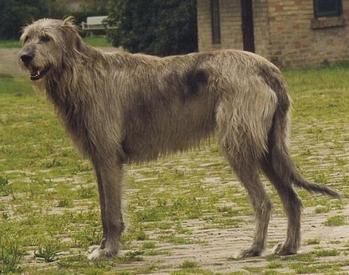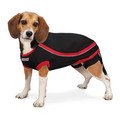
Much conjecture surrounds the exact origins of the Irish Wolfhound breed, with popular belief placing it in England as early as 7,000 BC. Mentioned in a letter written by the Roman consul Quintus Aurelius Symmachus to his brother in 391 CE, the Irish Wolfhound is steeped in ancient history. Primarily bred to hunt wolves, the Irish Wolfhound established a concrete reputation for itself as a game and rapid hunter, valued for its fearlessness and stamina. Gifted amongst the royal courts of Europe, the breed appeared in the households of Edward III, Henry VIII and Elizabeth I. By the 18th century, Britain's wolves had been hunted to extinction, thus removing the demand for these dogs. Had it not been for the efforts of Captain George Graham, the Irish Wolfhound would have disappeared along with the wolves. Officially recognised by the AKC in 1897.
A dog of impressive size and stature, the modern Irish Wolfhound is commonly observed as a companion and guard dog. Possessing long limbs, a deep chest for enhanced lung capacity, a long, tapering muzzle, dark eyes and small ears. The coat is typically rough and of a moderate length, whilst commonly appearing in colours of grey, brindle, fawn, white, black or red. A giant breed, the Irish Wolfhound is one of the tallest on the planet, with some reaching up to 7 feet tall when standing on their hind legs. A rustic-looking breed boasting an athletic and defined structure that is not easily mistaken.
Often described as the 'gentle giant,' the Irish Wolfhound possesses an affectionate and mannered nature, being fiercely devoted to its family and master. Slow to mature but eager to please, the Irish Wolfhound is well suited to relaxed or active family life, providing its needs for exercise and human companionship are met. Whilst not a territorial breed, the Irish Wolfhound can display reticence around strangers until it has familiarised itself with them, therefore early socialisation is important. On average, a healthy Irish Wolfhound will weigh anything between 40-70 kg depending on its gender, with a relatively short life expectancy of 6-8 years.
As with most large breeds, cardiac disease and orthopedic complaints are common. Mild breed-specific conditions include optical disorders, allergies and hip dysplasia, whilst more serious conditions include von Willebrand's Disorder, bone cancer, liver disease and gastric tortion, a potentially fatal complaint if left untreated for any length of time.








From Chieti, Italy
These are the sweetest dogs I have ever owned!! You cannot only have one...and they are just wonderful family members!!
From Lanarkshire, United Kingdom
Such gentle big giants, Although not so gentle when they try to sit on your lap.
Seamus is a digger, when he gets excited he will zoom round the garden then start digging. He is our World